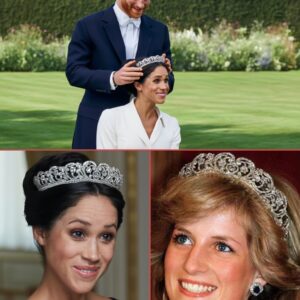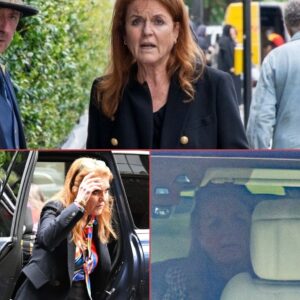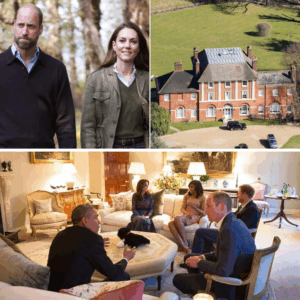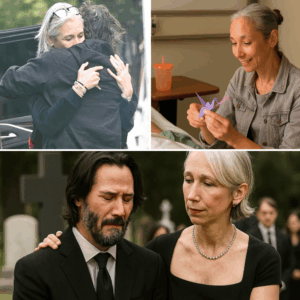Under the grand chandeliers of Windsor Castle’s opulent State Apartments, where history whispers through every gilded frame and velvet drape, Catherine, Princess of Wales, stepped into a moment that transcended time on the evening of September 17, 2025. It was the State Banquet honoring the second official visit of United States President Donald Trump and First Lady Melania Trump—a diplomatic spectacle blending transatlantic alliances with the timeless pomp of the British monarchy. But amid the clink of crystal and the murmur of world leaders, it was Kate’s entrance that commanded silence. She glided in on Prince William’s arm, her silhouette a vision of ethereal gold: a bespoke long-sleeve gown by British designer Phillipa Lepley, hand-embroidered with intricate Chantilly lace over ivory silk crepe, its high collar blooming with satin-stitched roses and French knots. Yet it was the crown atop her upswept waves—the Cambridge Lover’s Knot Tiara, a heirloom once beloved by Princess Diana—that ignited a global reverie. Paired with drop earrings from Queen Elizabeth II’s collection, Kate embodied not just regal poise, but a profound bridge across generations, honoring the woman whose shadow she has gracefully embraced for over a decade.
The tiara, a dazzling cascade of 19 pearl drops suspended from diamond-set knots, caught the light like morning dew on a spider’s web. Crafted in 1913 by Garrard at the behest of Queen Mary, it was a faithful recreation of an 1818 piece owned by her grandmother, Princess Augusta. Queen Elizabeth II inherited it, wearing it sparingly—its weight, both literal and figurative, a reminder of the burdens crowns impose. But it was Diana who transformed it into an icon of vulnerable glamour. Gifted to her upon her 1981 marriage to then-Prince Charles, Diana donned the Lover’s Knot for state dinners and diplomatic galas, its soft pearls a counterpoint to her bold spirit. She wore it to the 1985 Birthright Ball, her smile radiant against the pearls’ luster; to a 1991 dinner in Germany, where it framed her face like a halo amid geopolitical tensions. “It was her favorite,” royal jewelers have long whispered, a piece that softened the monarchy’s edges, much like Diana herself. After her 1996 divorce, the tiara returned to the royal vault, a quiet casualty of fractured fairy tales. Now, at 42, Kate has claimed it as her signature—wearing it more times than Diana ever did, each appearance a subtle reclamation of legacy.
As Kate descended the crimson-carpeted Grand Reception Room, flanked by William in his crisp black tailcoat adorned with the Order of the Garter, the air seemed to thicken with emotion. President Trump, seated at the high table with King Charles III and Queen Camilla, reportedly leaned toward Melania with a grin: “Now that’s what a princess looks like.” But for William, the sight was profoundly personal. Sources close to the couple reveal he squeezed Kate’s hand under the table, his voice low and choked: “Mum would have loved this.” It was a sentiment echoing a private moment from their 2011 wedding preparations, when William, selecting Diana’s sapphire engagement ring for his proposal, told Kate, “It’s my way of keeping her close.” Here, in Windsor’s gilded glow, the tiara became another thread in that tapestry—a living emblem of continuity, where Diana’s grace informs Kate’s resolve.
The gown itself wove further homage. Phillipa Lepley’s creation, with its gold-corded embroidery evoking English gardens in bloom, nodded to the bespoke elegance Diana championed through designers like Catherine Walker and Bruce Oldfield. Lepley, a rising star in British couture known for bridal confections worn by the likes of Meghan Markle and Pippa Middleton, tailored the piece to Kate’s specifications: a nod to the structured romance of 1980s royal eveningwear, yet modernized with sheer lace sleeves that hinted at vulnerability. Beneath the overlay, the silk crepe hugged Kate’s frame like a second skin, its ivory hue a deliberate echo of Diana’s 1981 wedding gown—simple, ethereal, burdened by expectation. “It’s not mimicry,” a palace stylist confided post-event. “It’s evolution. Kate honors Diana by building on her foundation, not recreating the blueprint.” The earrings—Queen Elizabeth’s signature pearl drops, once loaned to Diana for a 1982 banquet—completed the triad: past, present, future queens intertwined.
The banquet unfolded like a meticulously choreographed ballet. Guests, including Vice President JD Vance and a cadre of diplomats, dined on a menu of poached Scottish langoustines, saddle of lamb with herb-infused jus, and a dessert of elderflower panna cotta adorned with gold leaf—cuisines bridging British tradition and American flair. Toasts rang out: King Charles praising “the enduring alliance across the pond,” Trump quipping about “making the world great again, together.” But eyes lingered on Kate. As she engaged in animated conversation with Melania—discussing, insiders say, the shared trials of public motherhood—her poise was magnetic. No fidgeting, no forced smiles; just the quiet confidence of a woman who has navigated cancer’s shadow and emerged luminous. Her 2024 abdominal surgery and subsequent chemotherapy had sidelined her for months, her absences fueling feverish speculation. This return, mere weeks after her September 10 health update video, was no mere formality. It was a declaration: The Princess of Wales endures.
Social media erupted in real-time, a digital chorus amplifying the night’s magic. #KateDiana trending worldwide, amassing over 5 million posts by midnight. “Modern-day Diana, but with better armor,” one viral tweet read, paired with side-by-side images of Kate in gold lace and Diana at a 1985 gala in midnight blue. Fan accounts dissected every detail: the tiara’s pearls swaying like gentle waves, the gown’s roses symbolizing renewal. “She’s not stepping into Diana’s shoes—she’s walking beside her,” another user posted, garnering 200,000 likes. Critics, ever-present, nitpicked: “Too derivative,” some grumbled, echoing the scrutiny Diana faced in her youth. But the tide favored adoration. Celebrities chimed in—Oprah Winfrey reposting a photo with a single heart emoji; Emma Watson calling it “elegance with soul.” On X, a thread comparing Kate’s tiara moments to Diana’s went viral, tallying 1.2 million views: “Kate’s worn it 12 times; Diana, 6. Who’s the true heir now?”
This wasn’t Kate’s first dance with Diana’s wardrobe ghosts. Her style has long been a love letter to the People’s Princess, subtle yet seismic. At the March 10, 2025, Commonwealth Day service at Westminster Abbey—her triumphant post-treatment return—she recycled a scarlet Catherine Walker coat dress, a designer Diana adored, pairing it with the Collingwood Pearl Drop Earrings, gifted to Diana pre-wedding in 1981. The earrings, diamond-framed South Sea pearls, have a storied path: Diana wore them to her 1982 banquet for Queen Beatrix; Kate debuted them at Prince Louis’s christening in 2018. That day, Kate layered them with Elizabeth’s four-strand Japanese Pearl Choker, a piece loaned to Diana in 1983 for a Bangladesh visit. “It’s a conversation in jewels,” fashion historian Bethan Holt observed. “Kate layers history, turning accessories into narratives.”
Trooping the Colour on June 14 brought another echo: a turquoise Catherine Walker coat dress mirroring Diana’s 1988 polo outing, complete with white lapels and a matching Gina Foster hat. Kate’s daughter, Princess Charlotte, six, coordinated in aquamarine, her frock a pint-sized tribute. “Mother-daughter symmetry,” royal watchers cooed, recalling Diana’s 1987 Easter coordination with young William. At the VE Day 80th anniversary on May 8, Kate rewore a polka-dot Erdem dress echoing Diana’s 1988 Ascot whimsy, accented with those same Collingwood earrings—minus one diamond, a quirky imperfection adding to their charm. And in July, for French President Emmanuel Macron’s visit, Kate debuted in Dior, channeling Diana’s 1990s French flair with the Lover’s Knot Tiara and pearl drops, her red silk creponne gown by Sarah Burton a cape-shouldered masterpiece.
These nods are no accident. Kate’s fashion diplomacy—curated with input from her trusted stylist, Natasha Archer—serves the Crown’s soft power. Post-2023, amid King Charles’s cancer battle and the Firm’s slimmed-down roster, Kate’s appearances carry outsized weight. Her choices amplify unity: blending Diana’s accessibility with Elizabeth’s restraint, Walker’s romance with McQueen’s edge. “She’s the monarchy’s style diplomat,” Holt noted. “In a world of fast fashion, Kate curates heritage, making the past feel present.” Financially, it’s savvy too. The Phillipa Lepley gown, estimated at £25,000, spotlights British artisans; the tiara, valued at £10 million, underscores the royals’ jewel vault as a national treasure.
Yet beneath the sparkle lies deeper resonance. For William, 43, these moments heal old wounds. Diana’s 1997 death left him adrift, her sapphire ring a talisman against grief. Marrying Kate in 2011, he found not a replacement, but a partner in preservation. “Catherine understands the ghosts,” a friend shared. Their Adelaide Cottage home brims with Diana’s touches: her watercolor collection on walls, her Cartier clock ticking in the hall. The children—George, 12; Charlotte, 10; Louis, 7—know their “Gan-Gan” through stories, videos, and these inherited gems. At the banquet, George, debuting in white tie, beamed at his mother’s entrance; Charlotte, watching via broadcast, later drew a tiara-clad figure labeled “Auntie Kate.”
As the evening waned—speeches concluded, canapés savored—Kate slipped into a quieter role, mingling with veterans and aides. Melania, in a stark white column by Ralph Lauren, complimented the gown; Trump, ever the showman, posed for selfies. By 11 p.m., as guests departed under starry Berkshire skies, Kate and William retreated to Kensington Palace, the tiara safely vaulted once more. In the days since, reflections pour in. James Middleton, Kate’s brother, texted her: “Proud doesn’t cover it—you’re magic.” Royal biographer Robert Lacey called it “the night’s true diplomacy: healing across eras.”
In an institution often critiqued for rigidity, Kate’s tribute was revolutionary—soft power wrapped in gold lace. She doesn’t mimic Diana’s tragedy; she channels her triumph. As future Queen Consort, Kate carries the legacy not as a yoke, but a lantern: illuminating paths for her children, her husband, her nation. In that Windsor moment, with pearls swaying and diamonds aglow, she whispered to history: “We’ve got this.” And in the hearts of millions, Diana smiled back.





